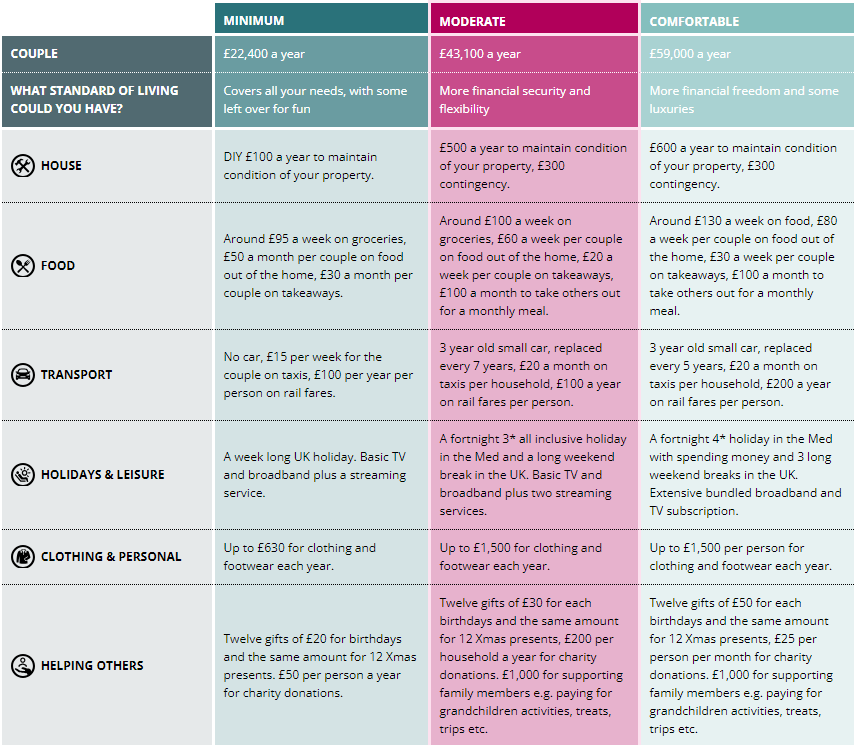Income needed for a comfortable retirement reaches new highs
The latest update to the Pensions and Lifetime Savings Association’s (PLSA) ‘Retirement Living Standards’ has revealed that a ‘moderate’ standard of living in retirement could now require over a third more income to account for the rising cost of living.
This means that for the ‘moderate’ retirement, which many savers aim for, a single person would need roughly £8,000 more in 2023/24 than they did in 2022/23. A total of £31,300 in 2023/24 is required, up 34% from £23,300 the year prior.
The thresholds for ‘minimum’ and ‘comfortable’ retirements also increased from the previous year, with a ‘minimum’ retirement living standard costing 13% more, up from £12,800 to £14,400, and a ‘comfortable’ retirement living standard costing 16% more, up from £37,000 to £43,100.
Arrange your free initial consultation
The table below displays the exact updated figures for each threshold. It’s important to note that these figures only represent the cost of retirement living now and do not account for future changes. If you don’t plan to retire for years, it’s important to consider how these thresholds may increase with future inflation.
| PSLA Retirement Living Standards | SINGLE | COUPLE | ||||
| 2024 level of income | Previous level | % Increase | 2024 level of income | Previous level | % Increase | |
| Minimum | £14,400 | £12,800 | 13% | £22,400 | £19,000 | 18% |
| Moderate | £31,300 | £23,300 | 34% | £43,100 | £34,000 | 27% |
| Standard | £43,100 | £37,300 | 16% | £59,000 | £54,400 | 8% |
Figure 1 - PSLA Retirement Living Standards, Source: Pensions and Lifetime Savings Association, 2024
With the state pension potentially rising to 71 by 2050, it’s more important than ever to seek professional financial advice to ensure you’re prepared as retirement living costs continue to increase.
How do the thresholds work?
The thresholds, called the ‘Retirement Living Standards’, are intended to provide a very rough guide to how much different retirement lifestyles might cost and what they would generally allow for in terms of budget. The ‘minimum’, ‘moderate’ and ‘comfortable’ categories attempt to convey a realistic picture of life by assuming that everyone, including those targeting a ‘minimum’ standard of living, will want to at least have some kind of social life and the occasional takeaway while still being able to pay essential bills.
For example, the ‘minimum’ living standard assumes one weeklong UK holiday per year. By contrast, the ‘comfortable’ living standard, budgets for a fortnight 4 star holiday in the Mediterranean with spending money and three long weekend breaks in the UK. The moderate living standard assumes a more realistic 3 star all-inclusive fortnight holiday in the Mediterranean and a long weekend break in the UK.
Some of the key assumptions that inform the Retirement Living Standards are detailed in the table below. These living standards assume no mortgage or rental costs.

Figure 2 - Types of expenditure, Source: Pensions and Lifetime Savings Association, 2024
*The figures shown are the amounts of annual expenditure required to achieve the living standard (ie they are not gross income figures).
With the cost of living in retirement on the rise, it’s more important than ever to manage your retirement plans carefully to ensure you don’t get caught out. If you want to find out more about how you can navigate these changes, why not give us a call on 0333 323 9065 or book a free non-committal initial consultation with one of our chartered advisers to find out how we might be able to help you.
Arrange your free initial consultation
This article is intended for general information only, it does not constitute individual advice and should not be used to inform financial decisions.

